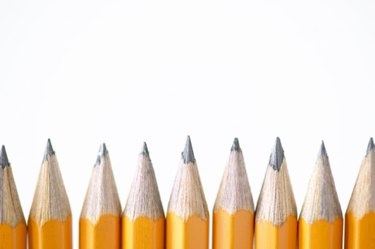
Pencil rubbings allow you to gather and recover lost information. They can be used on a pad of paper to recover a phone number that was lost or on a weathered gravestone on which the text is no longer legible. Rubbings are also great activities for kids. They can help kids to visualize the past and bring to light details that are easily missed. Genealogists often make rubbings of gravestones to make portable records of births and deaths.
Step 1
Select an object with texture on the surface. A gravestone is excellent because the names and dates are engraved into the stone. A pad of paper will have an indent of whatever was written on the page above it. An embossed image will also work. Embossing is the opposite of engraving, with information or the image raised from the surface instead of sunken in. Flat objects (such as typed words) will not produce a rubbing.
Video of the Day
Step 2
Place a blank piece of paper (white is typically best) over the image to be transferred. You can use masking tape to hold the paper in place without damaging the object.
Step 3
Hold a pencil at about a 20-degree angle or less, so that the exposed lead (not just the tip) is against the paper. Rub vigorously.
Step 4
Focus on dark lines as the image appears, to help the clarity of the image. The rubbing will be complete when you are satisfied with the darkness and shading of the image.
Tip
Aside from pencils, you can use pastel crayons for rubbings, as they have more usable surface area for writing.
Warning
Rubbings are not typically clear or crisp. They are used to help visualize what an object looks like, but are not a completely accurate representation.
Video of the Day